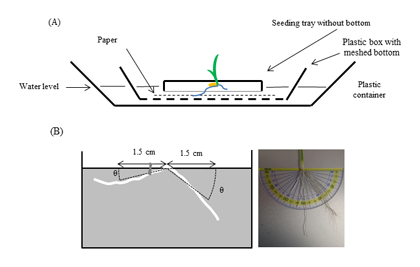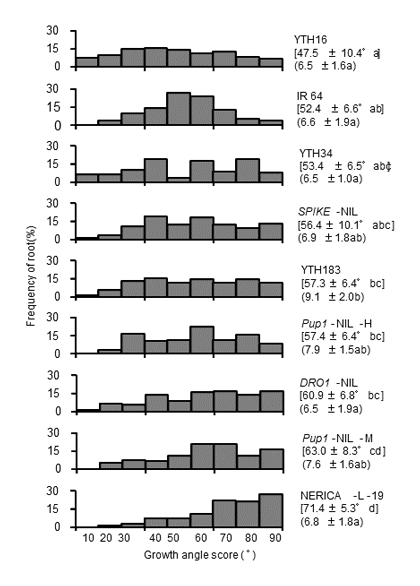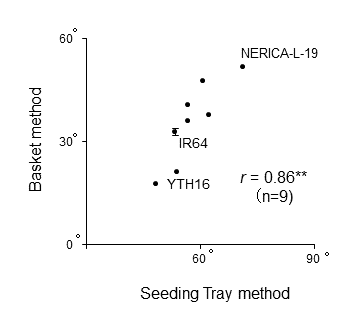Evaluation method of root angle distribution at seedling stage in rice (Oryza sativa L.)
Description
Root type has been one of the breeding targets after the Green Revolution in rice, but research efforts related to genetic improvement of root type was not focused and knowledge accumulation was slow. Evaluation of rice root type is a difficult research subject. Hanzawa et al. (2013) investigated root architecture using a basket as an evaluation method. Unfortunately, the basket method cannot handle a large number of plants and is unsuitable for variation or genetic analyses using many germplasms and big population sizes in hybrid populations. A more efficient evaluation method for root architecture of rice is therefore necessary to clarify the genetic variation of rice germplasms and hybrid populations.
The results of investigation using the seedling tray method agreed with those of the basket method (Fig. 3), and it confirmed the effect for the evaluation of root angle distribution in rice.
The advantages of the seedling tray method are as follows: shorter duration of rice seed cultivation, bigger population size of rice samples per square meter, and more detailed score scaling compared with that of the basket method for evaluating root angles (Table 1).
The seedling tray method will be useful in evaluating root types or architectures in rice cultivars, conducting genetic analysis of hybrid populations with big population sizes, and surveying genetic variation in germplasm, which means that this method will be a key technology for root type breeding in the future.
Figure, table
-
Fig. 1. Seedling tray method for evaluation of crown root angle distribution in rice seedling stage.
(A) Set up the seedling tray without bottom in the container. Seedling tray is divided into 17 rows and 2 steps, and 34 rice seedlings are cultivated at the same time. (B) Investigation of growth angle of crown roots from horizontal line, at 14 days after sowing (Modified from Tomita et al. 2017). -
Fig. 2. Root angle distributions in IR 64 and eight accessions with the IR 64 genetic background were investigated using the seedling tray method.
he averages of YTH16 and Dro1-NIL were calculated using 22 plants, and the others were calculated using 12 plants. [ ]: Average ± SD of RVA, ( ): Average ± SD of TRN, TRN: total root number, RVA: root vertical angle. Values denoted by different letters are significantly different at P = 0.05 by the Tukey-Kramer test. (Modified from Tomita et al. 2017). -
Fig. 3. Root vertical angle (RVA) relationship between the basket and seedling tray methods in IR 64 and eight accessions with the IR 64 genetic background.
Average values of RVA for each accession were used as representative data in the seedling tray method and in the basket method of Hanzawa et al. (2013). Error bars indicate SD for each accession. **: significant at P = 0.01 (Modified from Tomita et al. 2017). -
Table 1. Differences of effects between seedling tray method and basket method Item Seeding tray method Basket method Duration of cultivation (days) 14 21 No. of plants per 1m2 137 44 Scales for root angles 9
(0-90)4
(0,15, 45, 75)
- Research project
- Program name
- Term of research
-
FY2017(2016~2017)
- Responsible researcher
-
Fukuta Yoshimichi ( Tropical Agriculture Research Front )
Obara Mitsuhiro ( Biological Resources and Post-harvest Division )
Tomita Asami ( University of Tsukuba )
Sato Tadashi ( Tohoku University )
KAKEN Researcher No.: 40134043Uga Yusaku ( Institute of Crop Science, NARO )
- ほか
- Publication, etc.
-
https://doi.org/10.1270/jsbbs.16185
Tomita A et al. (2017) Breeding Science, 67: 181-190
- Japanese PDF
-
A4 294.83 KB
A3 286.58 KB
- English PDF
-
A4 267.94 KB
A3 196.37 KB
- Poster PDF
-
2017_B06_poster.pdf341.52 KB



